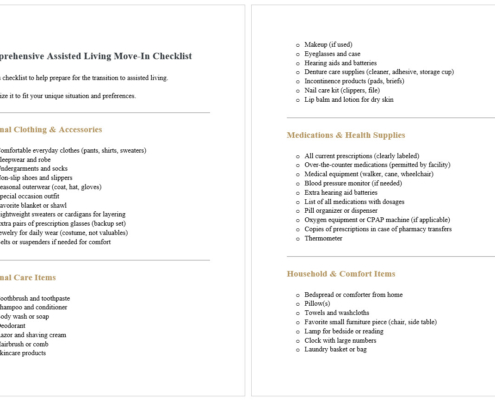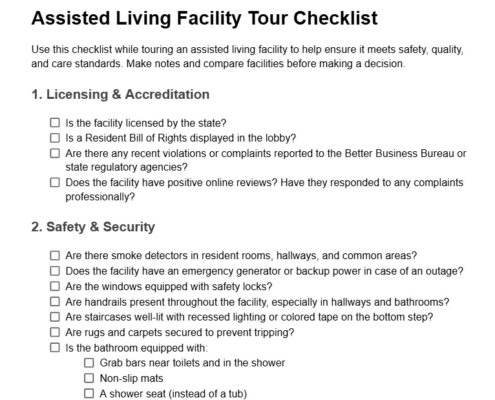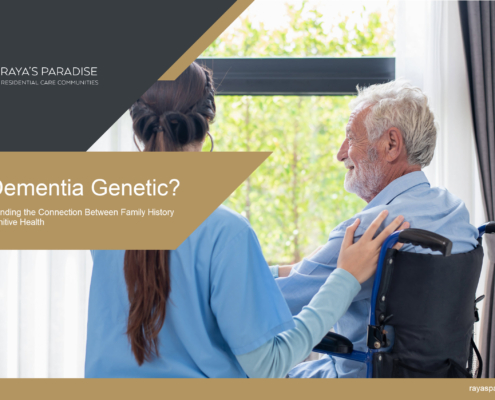Contents
- Using Life Insurance to Pay for Assisted Living
- Key Takeaways
- What It Means to Convert a Life Insurance Policy for Care
- What Makes This Option Appealing?
- Where It May Fall Short
- When It Makes Sense to Explore
- Personalized Assisted Living Support at Raya’s Paradise
- More Assisted Living Resources
- Does Assisted Living Provide Medical Care? Understanding Living Options and Care in Assisted Living Communities
- What Amenities Are Offered in Assisted Living? Services, Benefits, and Features for Residents
- What Is the Difference Between Assisted Living and Independent Living? Understanding the Options
- Assisted Living Move-In Checklist (Free PDF Download and Print)
- Assisted Living Facility Tour Checklist – Free PDF Download & Printable Guide
- Assisted Living vs. Senior Living - How Are They Different?
- What is Assisted Living and How Does it Work?
- What Are the Benefits of Assisted Living? 24-Hour Support, Socialization, Nutritious Meals and Peace of Mind
- Cost of Assisted Living in the Greater Los Angeles Area
- When’s the Best Age to Move to a Board and Care Community?
- Using Life Insurance to Pay for Assisted Living
- Is Dementia Genetic?
- How to Thank Assisted Living Staff
- How Often Should You Visit Your Parent in Assisted Living?
- Tips for Getting Cozy in Assisted Living
Using Life Insurance to Pay for Assisted Living
Exploring How an Existing Policy Can Offset Long-Term Care Costs
Finding ways to afford assisted living can be one of the most difficult parts of planning long-term care. While traditional savings, long-term care insurance, and Medicaid planning often take center stage, there’s a lesser-known strategy that may offer relief; converting a life insurance policy into a long-term care benefit. This method doesn’t work for everyone, but for those who qualify, it can help bridge financial gaps without giving up needed care.
Key Takeaways
Some life insurance policies can be converted into monthly payments that help cover assisted living costs.
Funds are paid directly to care providers, not the policyholder or family.
This strategy may be more valuable than surrendering a policy for cash.
It’s best for people who already need care and no longer rely on the policy for estate planning.
What It Means to Convert a Life Insurance Policy for Care
Many older adults hold life insurance policies they no longer need, especially if their dependents are grown or their financial goals have shifted. Through a long-term care benefit plan, policyholders can transfer ownership of a qualifying policy to a third-party administrator who then manages the policy, pays the premiums, and distributes monthly care payments on the individual’s behalf.
Payments are made directly to the assisted living or memory care provider, not to the family. In most cases, the provider will work with the administrator to verify eligibility, approve care needs, and manage ongoing billing. A portion of the policy, typically 5% to 10%, may be set aside to help with final expenses, such as funeral costs.
As an example, someone with a $50,000 life insurance policy might qualify for $20,000 to $25,000 in care benefits spread out over a set number of months, depending on health needs and plan structure.
What Makes This Option Appealing?
Many families appreciate that this type of benefit avoids ongoing premiums, especially if the policyholder is no longer working or financially independent. Payments begin soon after approval, which can help families cover costs faster than if they applied for Medicaid or new long-term care insurance. In many cases, the value of the benefit is higher than the policy’s cash surrender amount.
This strategy may also support Medicaid planning by reducing countable assets. Since the funds are paid directly to the facility, rather than to the individual, the benefit won’t typically be treated as income or an asset under Medicaid rules. Still, it’s important to confirm details with a qualified elder law advisor.
Where It May Fall Short
There are situations where this option won’t make financial sense. Policies with small face values, typically under $10,000, may not qualify. In some cases, surrendering the policy or considering a life settlement may result in better value. Most of the death benefit is forfeited, which may not be acceptable if the policy was intended for heirs.
To qualify, the person must already require care, usually within 90 days, and have documentation to support the level of assistance needed. The conversion will rarely cover 100% of assisted living expenses, but it can help reduce monthly out-of-pocket costs when other funding sources fall short.
When It Makes Sense to Explore
This solution can be worth exploring if a loved one has a life insurance policy that’s no longer essential for family protection and the need for care is urgent. It can be especially helpful when long-term care insurance isn’t in place or won’t kick in soon enough. It’s always wise to compare this approach against life settlements, hybrid LTC policies, or using the surrender value directly.
Talk to a licensed financial advisor or elder care planner to understand how the conversion would impact your situation and whether it aligns with your broader financial goals.
For more general information on planning and paying for senior care, you can also explore resources from the National Council on Aging.
Personalized Assisted Living Support at Raya’s Paradise
At Raya’s Paradise, we understand how overwhelming it can be to sort through care options while juggling financial concerns.
Whether you’re paying privately, using long-term care insurance, or considering strategies like life insurance conversion, our team is here to guide you with clarity and compassion.
Call us today at (310) 289-8834 or email info@rayasparadise.com to speak with a care advisor or schedule a visit to one of our residential care communities.

















